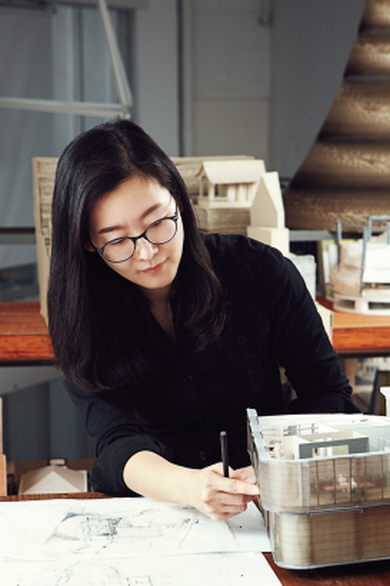
“Not to intrude my neighbors’ access to sunlight, we had to cut away a part of the roof,” architect Chun Sook-hee (’98, Architecture) said.
Due to this structural arrangement, a triangle was made on the roof which formed the shape “Y” seen from a distance. Located in a residential area in Seongdong-gu, Y-house is a place where architect Chun works.
In the field of architecture, Chun is referred as a “vegetarian”; not that she does not eat any meat, but her vocation as an architect can be summarized as “smallness” and “affinity.” In contrast to the traditional image of architecture associated with massive structures, Chun, as a “vegetarian” architect, puts more efforts in improving living space and community space.
“What I mean by smallness is a counterpart to grand and strictly purpose-oriented projects,” Chun replied. “With the understanding of the environment, needs of the people and their daily routines, I hope to make houses or buildings that could be enjoyed by everyone, regardless of economic or social status.”
Her definition of “smallness” is directly reflected in her previous projects. Undertaking the project “War and Women’s Human Rights Museum,” Chun received the second prize in Seoul Architecture Festival 2012. The museum being a place to memorialize the victims of the comfort women system during WWII, Chun planned to establish a “narrative museum.”
Although there is no big signboard that helps visitors to understand the tour, there are narrative spaces in sequence that tell visitors about the story of the victims. For example, as visitors walk through a long, narrow lane paved with dark pebbles, they sense sorrows and sufferings of the victims.
“I prefer a memorial to be a place to deliver the story of the victims rather than a grand or solemn museum,” Chun remarked.
The emphasis on the role of the museum as a storyteller is also found in the basic building material of the musuem-bricks.
“That certain type of brick is not produced anymore,” Chun said. “Each brick I chose here represents an individual effort and determination that finds itself allied with the whole structure of the museum.”
Her preference of natural settings and array of buildings is also found in her favorite parts on Ewha campus.
“Frankly, the campus is not user-friendly with narrow lanes and steep climbs,” Chun said. “But all those old trees and buildings with history are remarkable.”
She highly praised the way in which the school is making an effort to preserve and restore old buildings.
“The pink tiles on the floor of Pfeiffer Hall are no longer produced,” Chun added. “And when the pieces get broken, the school keeps the bits and glues them together again.”
Chun explained the necessity of “harmonious density” of the campus with Sinchon. She thinks highly of the school’s efforts to keep out the pressure of excessive change such as modernized or high buildings on campus.
Chun emphasized that there is always a link between architecture and humans. She says the two cannot be separated from each other. According to her, unlike installation art, a house or a museum where people live or visit has to be sustainable. And the responsibility it has on humans can be expanded to its neighbors and city.
Consistent with her nickname, a “vegetarian” architect, she wants to make space for children and architecture that is harmonious with nature.
“I want to build something with the most natural building material-which is nature,” Chun said.
Chun added final words of advice for Ewha students, emphasizing the need to have personal time for self-improvement.
“As students study too much these days, I think there is insufficient time to enjoy different cultures and hobbies,” Chun said. “Getting high grades does not mean mastering the subject, so that students should adjust their goals to bringing more fundamental changes to their career rather than to focus on the results they receive.”
Lee Yoon-soo
yoonpamom@ewhain.net

